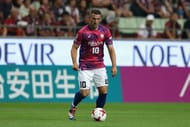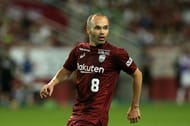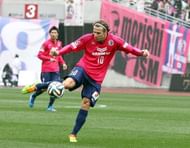Wrapped under the folds of a meteoric rise from the ashes, J1 League has turned out to be the best football league in Asia, after years of a tryst with mediocrity and sub-standard football conditions.
From sporting Arsene Wenger as a manager who set the course right for Japan stalwarts, Nagoya Grampus, J-League has hosted several foreigners in its illustrious history of 24 years. A few of them have been consistent regulars and a few appeared for guest performances. Guest or not, legends always leave their trail wherever they go. We will look at five of those legendary players who have graced J-League with their titanic presence and stamped their authority in the heart of Asian football.
#5 Lukas Podolski

Hailing from Germany, the legendary striker has plied his trade for several illustrious clubs including the likes of Bayern Munich and Arsenal before finally heading to Vissel Kobe after short stints at Galatasaray and Internazionale.
After a wondrous season at Galatasaray, Podolski headed for the land of the Rising Sun. Podolski kick-started his career with a brace in his debut to fire Vissel Kobe to a 3-1 victory over Omiya Ardija.
His first hat-trick for the Japanese outfit came in December of the recently concluded 2019 where he went on to pump in three goals against an ailing Jubilo Iwata.
The German marksman’s proliferation rate knew no bounds as his emphatic contribution to the club helped the team in winning their first major silverware in the apparition of Emperor’s Cup in January 2020.
With a magical figure of 15 goals from 56 games, Podolski still holds the key to a resurgent Vissel Kobe in an otherwise mediocre season.
#4 Andres Iniesta

As the 2010 World Cup Final was slowly headed towards a rip-roaring tie-breaker that would have featured two goalkeepers of the finest order locked in a face-off, Andres Iniesta’s wizardry shattered the hopes of millions and also the long-suspended impasse to propel Spain to their maiden World Cup triumph.
After spending 16 long years with the Catalans, Iniesta bade adieu to Nou Camp. Signed for a three-year deal, the Spanish central midfielder was roped in by Vissel Kobe to pull themselves out of the mid-table label.
His first goal for the Japanese contingency arrived against Jubilo Iwata in August 2018. His midfield display has helped Vissel Kobe to uplift themselves from the bottom half of the table to a respectable eighth position in a league of 18 teams.
With figures that read 9 goals from 37 games, his conversion rate as a central midfielder made him a feared opponent in the Japanese league.
Iniesta is still to announce his swansong and is most likely to play another season for Vissel Kobe before bowing out of the game forever.
#3 Fernando Torres

The striker who spearheaded Spain’s attacking force in three major tournaments, thereby firing the Red and Yellow brigade to glory in two European Championships and one World Cup, spent a lion’s share of his club career at Atletico Madrid before heading to Liverpool and Chelsea. He finally returned to the Madrid-based side after mediocre shows in Milan and silent days at Chelsea towards the end.
His days at Atletico Madrid in his second spell were numbered as all he could manage from 58 matches were 13 goals.
However, in the twilight of his career, El Nino finally chose to switch from popular world leagues to Asia’s most renowned league, as he donned on the jersey for Sagan Tosu.
His first goal for Sagan Tosu came against Vissel Kobe in the fourth round of Emperor’s Cup. Despite not being in good shape and with his goals drying up, Torres managed to bag 5 goals from 35 games, before finally pulling the plug on his career.
Sagan Tosu showed signs of improvement with the Spanish striker upfront, but lack of proper support in the midfield left Torres begging for opportunities.
#2 Diego Forlan

An emphatic performance that ended in despair for the Uruguayans, Diego Forlan provided the sole shaft of hope in the 2010 FIFA World Cup. After rattling the woodwork from a perfectly-executed free-kick from the edge of the penalty box that witnessed Germany getting lucky in the dying embers of the game to clinch the third position of the tournament, Forlan won the best goal of the tournament.
In the form of his life, Forlan also went on to score a brace in the finals of 2011 Copa America that was laced with Suarez’s thumping finish to accord Uruguay their 15th continental title.
After spending years with top clubs like Manchester United, Villarreal, Atletico Madrid, Forlan headed to Japan to don on the jersey of Cerezo Osaka. Despite, belting out a brief spell at Internacional and Internazionale, his days at both the clubs weren’t remarkable enough vis-à-vis the baseline of his standards.
His debut for Cerezo Osaka came in an AFC Champions League encounter against Pohang Steelers in a lacklustre 1-1 affair. His first goal for Osaka came against Buriram United in a 4-0 triumph of the Japanese outfit.
His first hat-trick came against Kyoto Sanga FC in the J2 League after his team got relegated in that season.
With the end of the season, Forlan called it a day at Japan to head over to his boyhood club, Penarol. His final figures in the Japanese colours read 17 goals from 42 games, an enviable one comparatively to the other legends gracing the league.
#1 David Villa

The bloke who scored a record 59 goals from 98 games for Spain and helped Del Bosque’s side secure their maiden World Cup, David Villa was always an avid maintainer of his numbers in any colour that he donned on.
After belting out four phenomenal seasons at the New York City where he went on to score 77 goals from only 117 games, he joined the Japanese stalwart, Vissel Kobe. A short yet a remarkable hostility prevailed between Villa and Melbourne City as he only played four games on loan and went on to score 2 goals
Villa played only 28 games in Kobe colours alongside his compatriot Andres Iniesta, netting 13 goals to surge hopes of the Japanese contingency.
His first goal in the J1 League came against Sagan Tosu in a closely contested encounter. His last day in the league witnessed him pumping in a penalty to end his playing days on a high.
Villa bowed out on his own terms, adding another silverware to his panoply as his swansong with the club was the final of Emperor’s Cup where Vissel Kobe trounced Kashima Antlers to lift the silverware.
